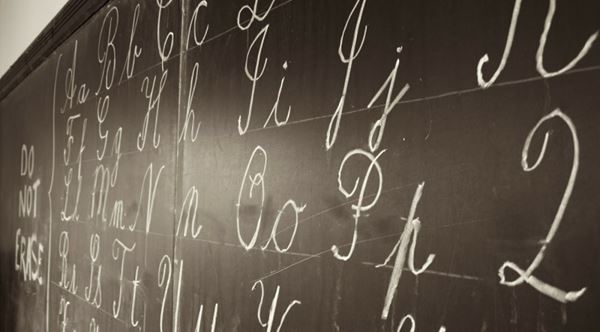Can Learning Cursive Make You More Prepared for College?
It happened with vinyl and Polaroids, so maybe it’s not surprising that a subject long thought on the way out is making a comeback. Cursive writing, not mentioned by the Common Core and required in just six states in 2010, will be required in elementary and middle school curriculums in nearly 20 states in 2019-2020.
Why? After all, students can take notes on a laptop, talk-to-text software is getting better all the time, and--except for a signature—when do we “need” to write longhand? Surely all keyboards, all the time, has made penmanship, well, quaint?
Not so fast. In places as different as Arkansas, California, and Michigan, cursive is being put back in the curriculum, for a variety of reasons.
In Texas, Abilene’s KTXS reported State Board of Education member Marty Rowley was in favor of a re-emphasis on cursive because the nation’s founding documents like the Constitution and the Declaration of Independence are written by hand, and students “are not able to (read them) if they don’t know cursive.”[1] This reason was also cited in the state legislative debates in New Jersey and Tennessee. Republican Louisiana state lawmaker Beth Mizell, the sponsor of a bill to reinstate cursive instruction in her state’s schools, decided to take action when she “heard from a surveyor who told her he couldn’t find young people who could read the notes on old land documents.”[2] But there were shouts of “America!” in the statehouse in Baton Rouge when it passed, so perhaps there was some patriotic fervor at play as well.[3]
But it’s more than nostalgia – there’s a growing body of research that suggests that writing by hand, and particularly in cursive, enhances brain development and fine-motor skills and helps young learners learn. An Indiana University study using functional MRI (fMRI) scans showed that when pre-literate five-year-old children[4] drew letters freehand, “…they exhibited increased activity in areas of the brain that are activated in adults when they read and write”[5], areas that were dormant in children who copied the letters or typed them on a computer keyboard.
This cutting-edge fMRI research seems to confirm that, as one writing specialist put it, “when the hands are involved, it’s a stronger association for learning and memory. When people write things they remember them longer” because various parts of the brain are interacting.[6]
This increased brain activity may be why students who are proficient at cursive—proficient enough to take notes by hand in a college classroom—do better on tests than their peers who took notes on a computer, as determined by a 2014 joint UCLA and Princeton study.[7] The study found that students who took notes longhand wrote fewer words and did measurably better on tests. The researchers concluded that the act of writing longhand increased performance, possibly because cursive imposes discipline, requires synthesis of a verbal lecture, and imprints content on the brain more effectively.
And there are significant benefits for students who learn differently, too. Cursive requires different areas of the brain to interact efficiently, and for students with dyslexia “… it integrates hand-eye coordination, fine motor skills and other brain and memory functions”[8] and significantly helps students learn to read and retain what they’ve read.
And some kids LOVE it! Students from Missouri, Texas, Wisconsin, Louisiana, South Carolina, and California have been quoted in articles from 2014 to this past week saying it looked “cool” or that it was “fun to write.” There’s even a summer camp in Connecticut where students aged 6-14 can study and practice writing in cursive for a week.[9] Students get to read old documents, hand-written post cards, and develop their own signatures—and there’s a waiting list.
There are camps for teachers to help them make cursive fun for their students, too. And they will likely have significant demand, as this coming year, 19 states[10] will mandate cursive instruction. Depending on where you live, the back-to-school shopping list may have more writing tablets, pens, and pencils than you remember—and if your list is a little hard to read due to your handwriting, well, there may be a class or camp coming soon.
[1] https://ktxs.com/news/local/texas-schools-to-reinforce-cursive-writing-in-curriculum [2] https://www.washingtonpost.com/local/education/once-all-but-left-for-dead-is-cursive-handwriting-making-a-comeback/2016/07/26/24e59d34-4489-11e6-bc99-7d269f8719b1_story.html?noredirect=on&utm_term=.e439c9138c48 [3] https://www.nytimes.com/2019/04/13/education/cursive-writing.html [4] https://www.sciencedirect.com/science/article/pii/S2211949312000038 [5] https://www.nytimes.com/2014/06/03/science/whats-lost-as-handwriting-fades.html [6] https://www.pbs.org/newshour/education/connecting-dots-role-cursive-dyslexia-therapy [7] https://cpb-us-w2.wpmucdn.com/sites.udel.edu/dist/6/132/files/2010/11/Psychological-Science-2014-Mueller-0956797614524581-1u0h0yu.pdf [8] https://www.pbs.org/newshour/education/connecting-dots-role-cursive-dyslexia-therapy [9] https://www.washingtonpost.com/lifestyle/style/from-punishing-to-pleasurable-how-cursive-writing-is-looping-back-into-our-hearts/2018/08/31/aa180b9c-aa06-11e8-a8d7-0f63ab8b1370_story.html?utm_term=.54b125251216 [10] Louisiana, Texas, Illinois, California, Alabama, Mississippi, North Carolina, South Carolina, Tennessee, Florida, Virginia, West Virginia, Utah, Michigan, Arizona, Idaho, Maryland, Missouri, Kansas
[1] https://ktxs.com/news/local/texas-schools-to-reinforce-cursive-writing-in-curriculum [2] https://www.washingtonpost.com/local/education/once-all-but-left-for-dead-is-cursive-handwriting-making-a-comeback/2016/07/26/24e59d34-4489-11e6-bc99-7d269f8719b1_story.html?noredirect=on&utm_term=.e439c9138c48 [3] https://www.nytimes.com/2019/04/13/education/cursive-writing.html [4] https://www.sciencedirect.com/science/article/pii/S2211949312000038 [5] https://www.nytimes.com/2014/06/03/science/whats-lost-as-handwriting-fades.html [6] https://www.pbs.org/newshour/education/connecting-dots-role-cursive-dyslexia-therapy [7] https://cpb-us-w2.wpmucdn.com/sites.udel.edu/dist/6/132/files/2010/11/Psychological-Science-2014-Mueller-0956797614524581-1u0h0yu.pdf [8] https://www.pbs.org/newshour/education/connecting-dots-role-cursive-dyslexia-therapy [9] https://www.washingtonpost.com/lifestyle/style/from-punishing-to-pleasurable-how-cursive-writing-is-looping-back-into-our-hearts/2018/08/31/aa180b9c-aa06-11e8-a8d7-0f63ab8b1370_story.html?utm_term=.54b125251216 [10] Louisiana, Texas, Illinois, California, Alabama, Mississippi, North Carolina, South Carolina, Tennessee, Florida, Virginia, West Virginia, Utah, Michigan, Arizona, Idaho, Maryland, Missouri, Kansas






